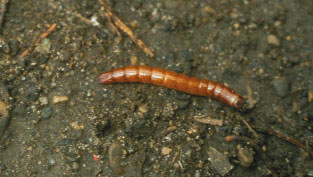What Is Your Wireworm Risk?
by Tracey Baute, Field Crop Entomologist, OMAF, Ridgetown
 |
|
Figure
1. Wireworm
(Source: Agronomy Guide, OMAF Publication 811) |
With a limited
supply of lindane seed treatment left in Ontario, there is growing concern
over what options are still available for corn growers to manage their wireworm
problem. Are you at risk and what options do you have left for this year?
What are wireworms? Wireworms are the larval
stage of click beetles. As their name implies, these larvae have hardened
wire-like bodies that are coppery-brown in colour and are approximately
8 to 35 mm in length (Fig. 1). The adult beetles are usually brown, black
or dark grey and make a clicking sound when they flip their bodies to right
themselves after being placed on their backs.
What can they do to the crop? Only the larval
stage causes injury to crops with corn, soybeans, cereals, edible beans
and potatoes being those most affected. Injury tends to be more pronounced
in wet, cool springs when the seed cannot germinate and establish quickly.
Seeds can be hollowed out, leaving only the empty hull, resulting in gaps
in the stand.
Roots of young seedling plants can be clipped, causing the plant to slowly
wilt while older seedling plants may be hollowed out just below the soil
surface at the base of the plant. Corn plants may turn purple at the base
as a result of their limited ability to take up phosphorous because of this
injury.
What are the risks? Wireworms can spend up
to 6 years in the soil as larvae, with the last few years of their cycle
being the most destructive. Feeding activity can begin as early as April,
once the soil warms, and continues through to June.
Fields most at risk are those with sandy soils, frequent grass crop rotations
and history of grassy weeds, or those following a sod, alfalfa or small
grains crop. Sandy knolls are especially at risk and should be monitored
regularly in the spring.
How do you scout for them? The best method
to scout for wireworms is to set up bait stations approximately three weeks
before planting. Two bait stations should be placed in every high-risk area
of the field. Construct a bait station by digging a hole 25 cm deep and
approximately 15 to 20 cm wide. Place a few freshly cut potatoes into a
loose mesh bag and place the bag in the hole. Loosely mound the soil over
the bait station to prevent standing water and place a flag at its position.
Securing a dark piece of plastic over the mound will help to warm the bait
station, increasing the fermentation of the potatoes, which will be more
attractive to the wireworms. Return to the bait station a few days before
planting, digging up the bag and examining its contents. If one or more
wireworms are found per bait station, control is necessary.
What control options are available? In the
past, lindane products like Agrox B-3, Agrox DL Plus and DL+C have provided
some protection to the seed. With the required withdrawal of lindane products
from the Canadian marketplace by December 2004, supplies are limited for
2003. Unfortunately, there are no other products currently registered for
seed protection against wireworms. It is important to note, however, that
even the lindane seed treatments do not provide protection to the seedling
roots. In moderate to heavy infestations, use of seed treatment alone is
not advisable and should be used in combination with in-furrow or banded
insecticides such as Force and Counter to ensure seedling protection. If
bait stations indicate moderate to high infestations, it might be worthwhile
to dust off the drill boxes and re-configure the planter for soil-applied
insecticide application. There are no effective rescue treatments available
once symptoms appear in the field.
With or without the use of a lindane product, the best thing that you can
do is to plant your seed in optimal conditions. Without a seed treatment,
it is the seed that is most vulnerable. Avoid seeding too early and planting
too deep. Give the plants the best opportunity to get established and growing
quickly to minimize the impact of wireworm feeding. Once the seedling is
established, soil-applied insecticides, if used, will provide the protection
needed. Also, increasing your seeding rates by 10-15% in high risk areas
of the field may help to compensate for some stand loss that may occur in
those areas.
The good news is that seed treatments coming to market shortly (i.e., Cruiser,
Gaucho and Poncho) do provide excellent control of wireworms and other soil
insects. The 2003 growing season might be a challenging one for some, but
by knowing what your risk is in your fields, you can be better equipped
to make the proper decisions necessary to help reduce this risk.
Back
to Top

